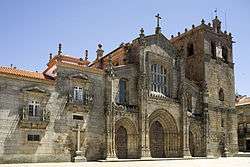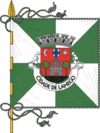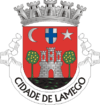Lamego
| Lamego | |||
|---|---|---|---|
| Municipality | |||
| |||
 | |||
| Coordinates: 41°6′3″N 7°48′36″W / 41.10083°N 7.81000°WCoordinates: 41°6′3″N 7°48′36″W / 41.10083°N 7.81000°W | |||
| Country |
| ||
| Region | Norte | ||
| Subregion | Douro | ||
| Intermunic. comm. | Douro | ||
| District | Viseu | ||
| Parishes | 18 | ||
| Government | |||
| • President | Francisco Manuel Lopes (PPD-PSD - CDS-PP) | ||
| Area | |||
| • Total | 165.42 km2 (63.87 sq mi) | ||
| Elevation | 644 m (2,113 ft) | ||
| Population (2011) | |||
| • Total | 26,691 | ||
| • Density | 160/km2 (420/sq mi) | ||
| Time zone | WET/WEST (UTC+0/+1) | ||
| Postal code | 5100 | ||
| Patron | Santa Maria Maior | ||
| Website | http://www.cm-lamego.pt | ||
Lamego (![]() Portuguese pronunciation: [lɐˈmeɣu]) is a city and municipality in the Viseu District, in the Norte Region of the Douro in northern Portugal. Located on the shores of the Balsemão River, the municipality has a population of 26,691,[1] in an area of 165.42 km².[2]
Portuguese pronunciation: [lɐˈmeɣu]) is a city and municipality in the Viseu District, in the Norte Region of the Douro in northern Portugal. Located on the shores of the Balsemão River, the municipality has a population of 26,691,[1] in an area of 165.42 km².[2]
With origins before the Roman occupation of the Iberian Peninsula, Lamego is known for its historic city center, having a long history as a principal city of the former Trás-os-Montes e Alto Douro Province. Legend holds that the first Portuguese Cortes were held in Lamego, in 1143.The Roman Catholic Diocese of Lamego is based in the city center.
Etymology
The toponomic name Lamego was derived from Lamaecus, a name Roman-Hispanic derivative to indicate the possessor of agrarian titles in the 3rd century around the local castle.[3][4]
History
.jpg)
The area around Lamego was inhabited by Ligures and Turduli, and during the Roman presence it was occupied by Coelerni, which left behind several monuments.[3] Due to the placement of the castle, it is likely that a castro originally existed on the site. During the Inquirições (Inventory/Enquiries) of King Afonso (during the 13th century) there was reference to the Castro de Lameco, referred to as a medieval fortification.[3] Destroyed by the Romans, the inhabitants were forced to descend into the valley and cultivate the land, as part of the Roman reorganization of the land.[3]
Middle Ages
Lamego became Catholic when the Visigothic king Rekared I converted to Catholicism. In 569, during the Council of Lugo, there appeared references to Sardinário the Bishop of Lamego.[3] During the reign of Sisebuto (612-621), the Visigothic monarch coined currency from Lamego, indicating the importance of the region to commerce and culture.
Just outside the city center is the tiny 7th century São Pedro de Balsemão Chapel, a Visigothic chapel believed to be the oldest in Portugal (and second oldest in Europe).[3]
A region alternated between peace and war in the following years as Christians and Muslims fought the territory during the Reconquista, until Ferdinand I of León and Castile conquered the region definitively on 29 November 1057. As a consequence the bishopric was moved after these events (to later be restored in 1071).[3]
In 1128, the nascent national Egas Moniz, had his tenancy in Lamego while his residence was in Britiande, as master of the Riba–Douro, between Paiva and Távora (in addition to the lands of Côa).[3]

The most significant moment in the town's history was in 1139, when nobles declared Afonso Henriques to be Portugal's first king. The town's Gothic cathedral was built by him, although only the Romanesque tower is left from the original building, with its carved Renaissance portal and fine cloister dating from the 16th and 18th centuries. The 12th-century castle preserves a fine keep and a very old and unusual cistern with monograms of master masons.
King Sancho I issued a charter of independence in 1191, as the local community grew around two poles: the ecclesiastical parishes of Sé and Castelo.[3] In 1290, King Denis provided a market charter to the city, attracting merchants from Castile and Granada with their oriental spices and textiles.[3]
Lamego had a privileged positioned on the routes from western Iberia, as a transit point within the settlements of the Além-Douro, Braga and Guimarães, from Alcântara and Mérida to Córdoba and Seville.[3] It was also one of the preferred routes on the Saint James Way pilgrimage to Santiago de Compostela. But, two events changed the economic and social circumstances in the region: the conquest of Granada which drove the last of the Moors from the Peninsula; and the discovery of the maritime connection to India, which resulted in a slow decline for the region.[3]
Early modern era

Manuel I of Portugal issued a foral (charter) in 1514. Also in the 16th century, Manuel de Noronha (one of the more notable prelates of Lamego) was appointed the Bishop of Lamego, occupying the role for the next 18 years and referred to the "great builder", responsible for the cult of Nossa Senhora dos Remédios (Our Lady of Remedies).[3]
In the 17th and 18th century, the solares (country estates) are slowly constructed in Lamego, resulting from the wine commerce down the Douro.
The economic growth of viticulture along the Douro resulted in the issuance of a writ by Sebastião José de Carvalho e Melo, 1st Marquis of Pombal, to designate the area as the Região Demarcada do Douro and the establishment of the Companhia Geral da Agricultura das Vinhas do Alto Douro (General Company of the Wine Agriculture of the Upper Douro).[3]
In 1835, Lamego was the capital of the district, but lost this title to Viseu (December 1835), under the authority of the King's Minister Luís Mouzinho de Albuquerque. In 1919, in an attempt to restore the monarchy, Lamego became the capital of the district for 24 days.[3]
During the second half of the 19th century, during the presidency of the Viscount of Guedes Teixeira, Lamego begins a process of modernization with the construction of new avenues.[3]
After the establishment of the First Republic, during the presidency of Alfredo de Sousa, Lamego undergoes a new phase of building, including the construction a bridge over the Coura River.[3]
Geography
| Population Growth (1849 - 20011) | ||
|---|---|---|
| Year | Pop. | ±% |
| 1801 | 14,688 | — |
| 1849 | 20,240 | +37.8% |
| 1900 | 31,835 | +57.3% |
| 1930 | 34,730 | +9.1% |
| 1960 | 36,320 | +4.6% |
| 1981 | 32,833 | −9.6% |
| 1991 | 30,164 | −8.1% |
| 2001 | 28,081 | −6.9% |
| 2011 | 26,691 | −4.9% |
Human geography
Administratively, the municipality is divided into 18 civil parishes (freguesias):[5]
Economy

The principal activities in this region are tied to the service sector, with commerce and agriculture also representing an important part of the economy. In particular viticulture, since the municipality (and other municipalities in the region) have been designated as part of the Denominação de Origem Controlada (DOC), a control used to classify wine products as a locally produced product of origin, for national and international marketing.
Lamego has a large shopping centre, with approximately 30 main shops, three malls of medium-size and several small traditional shops. Industrial activities are concentrated in the industrial zone in the parish of Várzea de Abrunhais. Lamego textiles are also promoted but tend to be small-scale production runs, with few medium- to large-companies involved in mass-production.
The tourist sector is primarily associated with the monuments and religious buildings, and has been a growing part of the local economy. The extension of the A24 motorway has been important in attracting more visitors and businesses to the region.
Culture

Lamego is considered one of the principal cities of the Portuguese Barroque, for its numerous churches, palaces, and civic buildings. The city is the seat of the Roman Catholic Diocese of Lamego and has a cathedral.
The following cultural institutions are based in Lamego:
- Ribeiro Conceição Theatre
- Lamego City Museum
- Lamego Municipal Library
- Lamego Image Archive
- Clav'Art
- APC - Amigos Pela Cultura
- ArqDoc – Lamego Document Archive
Notable people

- Egas Moniz, nobleman of the second County of Portugal (1080 - 1146)
- José Augusto Guedes Teixeira, Civil Governor of Porto District (1843 - 1890)
- Fausto Guedes Teixeira, poet (1871 - 1940)
- Gentil Guedes Gomes, writer (1896 - 1970)
- Fernando Monteiro de Amaral, 7th President of the Assembly of the Republic (1925 - 2009)
- Mário Lemos Pires, last Governor of Portuguese Timor (1930 - 2009)
- João Botelho, film director (1949)
- Álvaro Magalhães, writer (1951)
- José Maria Pedroto, footballer for F.C. Porto (1928 - 1985)
- Álvaro Magalhães, footballer for S.L. Benfica (1961)
References
- Notes
- ↑ Instituto Nacional de Estatística
- ↑ Direção-Geral do Território
- 1 2 3 4 5 6 7 8 9 10 11 12 13 14 15 16 17 Câmara Municipal, ed. (2011). "Lamego - Raízes Históricas" (in Portuguese). Lamego, Portugal: Câmara Municipal de Lamego. Retrieved 9 June 2011.
- ↑ M. Gonçalves da Costa (1977), p.45
- ↑ Diário da República. "Law nr. 11-A/2013, page 552 60" (pdf) (in Portuguese). Retrieved 24 July 2014.
- Sources
- Costa, M. Gonçalves da (1977), História do Bispado e cidade de Lamego (in Portuguese), 1, Lamego, Portugal
External links
| Wikimedia Commons has media related to Lamego. |

